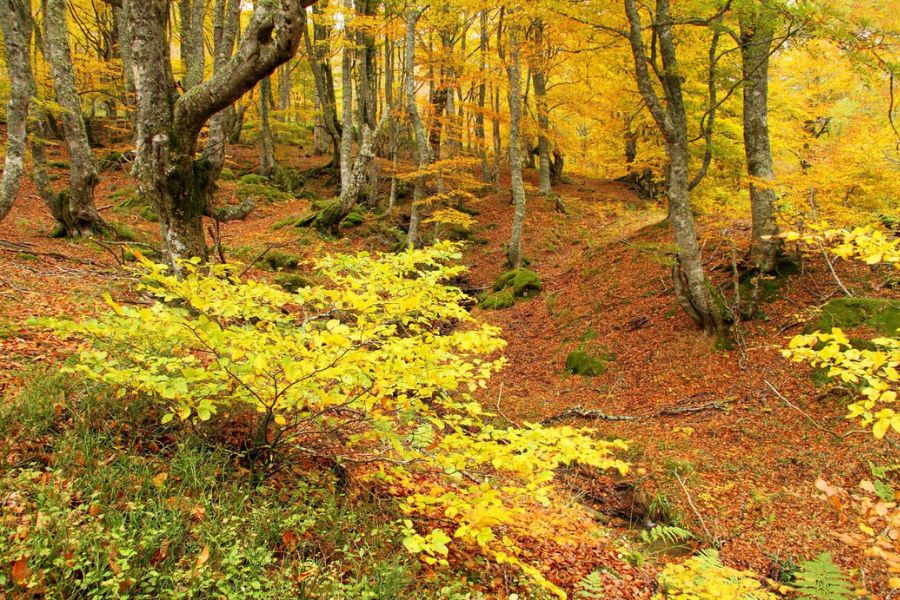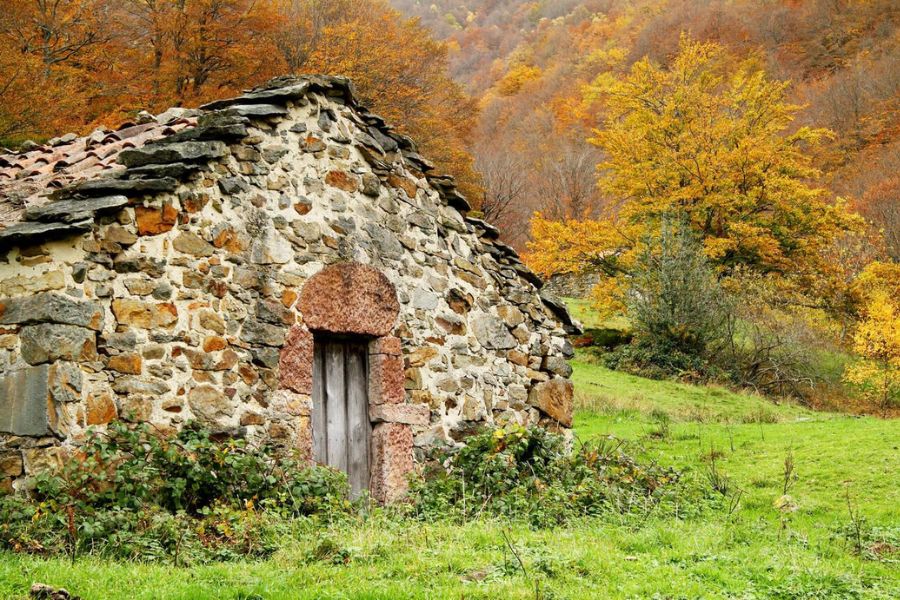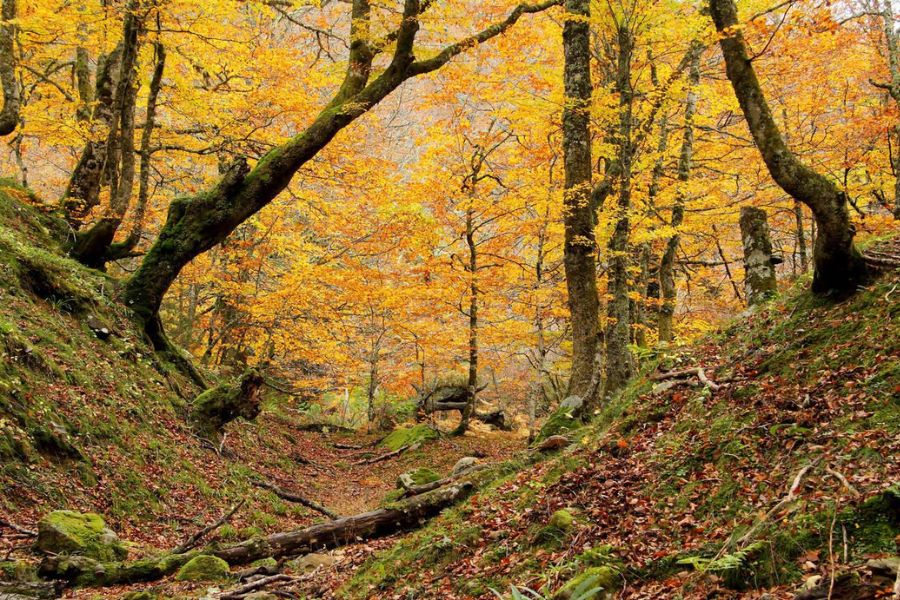When autumn rolls into Asturias, the crowds quietly disappear. The hiking trails become peaceful, and the forests turn golden under the changing leaves.
Honestly, autumn feels like Asturias’ best-kept secret. You get quiet forests, crisp air, and the cozy glow of cider houses—without elbowing past tourists. I can’t wait each year to wander among chestnut and beech trees, where the colors seem to set every path and village on fire.
These months let me see what truly makes Asturias special. Locals have more time to chat, the scenery hits peak beauty, and cider somehow tastes even better in a hushed bar.

Autumn just makes everything easier to enjoy.
Why Autumn Transforms Asturias
As the air chills and the forests light up in gold, Asturias changes in a way that always draws me back. The slower pace, the emptier trails, and the coziness of cider houses together create a kind of sanctuary.
It’s a season that rewards patience and a bit of imagination.
Golden Forests and Natural Beauty
Autumn completely transforms the valleys and hills of Asturias. Wild oak, beech, and chestnut trees explode in red, yellow, and gold.
Walking through the Picos de Europa or Somiedo Natural Park feels like wandering inside a painting. I stop often to admire wildflowers that survive beneath the crunchy leaves—little bursts of color hiding near old tree trunks.
The forests turn quiet and calm, a real break from daily noise. Even a short walk can feel magical if you let your imagination wander.

Sometimes I just stand still and listen to the leaves under my boots or a bird calling in the distance. The colors, the silence, the earthy smell—those details stick with me long after I leave.
Mild Weather and Vibrant Landscapes
Summer in Asturias can be hot and crowded, but autumn brings cool, comfortable days—usually around 12°C to 18°C (54°F to 64°F). The air feels fresh and a bit damp, perfect for long walks or easy bike rides.
I never have to hurry to escape the sun or find shade. The landscapes come alive.
Small villages tucked in the hills look even more charming surrounded by fiery leaves. Morning fog drifts through the valleys, making every view feel dreamy.
Sometimes it rains, but I don’t mind. It’s a good excuse to slow down, grab a coffee, or watch rain collect on late-blooming flowers.
With a light jacket and sturdy shoes, I can wander for hours without getting too hot or cold. The weather really brings out the best in Asturias’ mountains, beaches, and hidden trails.
Fewer Tourists, More Authentic Experiences
Visiting Asturias in autumn means I skip the summer crowds. Hiking trails, markets, and cider houses (sidrerías) often feel like they’re just for me.
Shop owners and cider makers have time to chat and share stories, which adds a real warmth to each visit. Autumn lets me experience Asturian culture without the rush.
I linger in cozy cider houses, watching locals pour sidra from high above their heads. Eating fabada in a quiet village just makes everything taste better.

With fewer tourists, everything slows down. People, wildlife, even time itself seem to let me linger and enjoy the details that autumn brings.
Cider Houses: The Cozy Heart of Asturian Autumn
As the days cool, sidrerías—cider houses—draw in locals and travelers alike. Warm lights, rustic touches, and the promise of fresh apple cider pull people together.
Traditional Sidrerías and Their Autumn Rituals
Walking into a sidrería feels like entering a friend’s living room. Stone walls are decorated with old cider barrels, faded farm tools, and autumn wreaths made from apples and leaves.
Tables sit close together, so it’s easy to strike up a chat with someone nearby.
In autumn, many sidrerías host special espicha parties. Cider flows straight from big barrels, and everyone shares plates of blue cheese, chorizo, and salt cod.
People dress up for the occasion—sometimes in cozy sweaters or even traditional Asturian outfits. It always feels like a harvest celebration, with friendship and old traditions at the center.
Savoring Fresh Apple Cider Among Friends
During cider season, I love watching the ritual of pouring—escanciado. Pourers lift the green bottle high, sending a thin stream of cider into a glass held low.
That aerates the drink and releases its crisp, tangy scent. It’s normal to share one glass, passing it around the table.
The ritual, and the thrill of a cold cider sip, builds a sense of friendship. I’ve laughed with locals as we compare pouring skills—nobody cares if you spill a bit.

The best evenings end with new friends, stories, and the cozy warmth that only an Asturian cider house can give.
Exploring Asturias’ Hidden Autumn Gems
When I first visited Asturias in autumn, I found a lot of beauty hiding off the main roads. Forests turn gold, trails go quiet, and villages burst with local traditions.
There’s a calm in the air, and a glass of fresh cider makes every stop memorable.
Secret Trails Through Golden Forests
Walking through autumn forests in Asturias feels like entering another world. Trails in places like the Picos de Europa and Somiedo National Park get covered in red, yellow, and brown leaves.
Some routes, like the Senda del Oso, are nearly empty—perfect for quiet hikes and peace.
Mornings bring a mist that lingers in the valleys, wrapping the woods in a magical light. On weekdays, I rarely see other hikers, but I always notice signs of wildlife—deer, birds, or just the sound of something moving in the leaves.
I keep a list in my notebook of hidden trailheads that locals share in handwritten notes or friendly chats.
If you need advice about family-friendly or adventure trails, the tourist offices in Oviedo and Cangas de Onís are helpful. Sometimes, though, the best tips come from locals scribbling directions on a napkin in a cider house.
Charming Villages With Local Flair
Asturias’ villages really come alive in autumn. Towns like Cangas de Onís and Villaviciosa feel lively but peaceful between tourist seasons.
Cider houses—or “sidrerías”—open wide, and I always feel at home sipping fresh sidra poured from a height while locals chat at rustic tables.

Here’s what stands out for me:
- Cider tastings at small, family-run sidrerías
- Autumn food markets with wild mushrooms and chestnuts
- Local festivals with music and dancing
- Stone houses with flower-filled balconies
When I get lost or need a tip for the best bakery or cider house, villagers are quick to help. I often leave with a handwritten note listing hidden spots to try next.
Every stop feels like a small discovery, made possible by the warmth and helpfulness of the people.
The Cultural Pulse of Asturias in the Fall
Autumn brings Asturians together with traditional festivals and events that show the real spirit of this northern Spanish region.
In the streets and cider houses, the cooler months bring out local music, flavor, and community ties.
Festivals and Community Events
One highlight of autumn in Asturias is the seasonal festivals that fill every town and village. The famous Antroxu harvest celebrations invite everyone—locals, visitors, even small businesses—to join public feasts and processions.
Tables overflow with chestnuts, apples, and hearty stews. Farmers’ markets pop up in village squares, where artisans sell handwoven goods and local NGOs host food drives and workshops for kids.
Some typical autumn events include:
- Magüestu: Chestnut-roasting festival with music and games.
- Cider pouring contests: Held in cozy sidrerías, where I’ve tried (and failed) to pour cider the traditional way.
- Apple harvest gatherings: Farmers welcome visitors for tours among golden orchards.
Art, Music, and Seasonal Celebrations
Asturias in the fall buzzes with folk music and visual art, much of it rooted in Celtic tradition. Local musicians play bagpipes and tambourines at outdoor concerts, and I’ve stumbled into spontaneous jam sessions in village plazas.
Art galleries and cultural centers, often run by community leaders or small NGOs, showcase work from local painters and sculptors. Autumn exhibits usually feature harvest, nature, and rural life.
I especially love seeing student and professional artists display landscapes painted in the season’s golds and greens.
Many sidrerías host live performances on weekends, mixing traditional dance with acoustic sets. For families or solo travelers like me, these events offer a firsthand look at Asturian culture.

Even with smaller crowds, the energy is welcoming—a real window into the region’s spirit.
Travel Tips for Your Asturian Autumn Adventure
Exploring Asturias in autumn means quieter sights, warm cider houses, and colorful forests. Planning for cool weather, winding roads, and fewer crowds makes the trip smoother and more fun.
Packing Essentials and What to Wear
Asturias’ autumn air is fresh and often damp, especially in the mornings and evenings. I always pack a lightweight waterproof jacket—rain can show up out of nowhere.
Layers help—t-shirts, sweaters, and a warm fleece for misty mountain trails. Hiking boots with good grip are essential, not just for the Picos de Europa but for muddy village paths too.
If rain’s in the forecast, I bring waterproof pants; nobody wants to spend the day in wet jeans. A small, sturdy umbrella fits easily in my daypack.
For cider house visits, I go for a casual but tidy look—jeans and a nice sweater. When exploring, a compact daypack is a must. It holds snacks, water, and extra socks. I never forget a power bank for my phone, especially on long hikes.
Quick List:
- Waterproof jacket
- Layered clothing
- Hiking boots
- Extra socks
- Umbrella
- Power bank
Transportation and Navigating the Region
Getting around Asturias can be an adventure. I usually rent a car for the freedom, since the prettiest spots are often outside the main cities.
Country roads twist through green hills and forests, so I take my time—especially after rain, since roads can get slick.
Public buses and trains connect Oviedo, Gijón, and some coastal towns. Schedules are limited on weekends and holidays, so I always double-check and set reminders for the last bus.
In remote villages, taxis might be the only option, though sometimes the wait drags on.
I download offline maps before I arrive. Knowing a little Spanish goes a long way, since some bus drivers or locals might not speak English.

Locals are usually friendly and patient if I ask for directions.
Saving Costs and Avoiding Inconvenience
Asturias in autumn doesn’t get packed, but I’ve found that planning ahead really stretches my budget and saves me from unnecessary hassle.
I usually book my accommodation early for weekends, especially in those rural towns—the coziest guesthouses seem to disappear fast.
If I’m taking the car, I always ask about parking first. Some village streets get so narrow or they’re reserved, so it’s better to know before showing up.
Eating out here stays pretty affordable, especially when I go for the menu del día. That set lunch is filling and the price is fair.
I like to keep some cash on me, since those tiny cider houses often don’t take cards.
Before I go anywhere, I check if there are any bank holidays or local festivals coming up. Buses and restaurants might suddenly close, or run on a weird schedule, and I’d rather not get caught off guard.
Honestly, a little flexibility makes a huge difference. When I travel off-peak, I get better prices and skip the lines, but I’ve learned to expect changes in opening hours or random weather.
With some forethought, I get to explore Asturias the way I want, without anyone rushing me around.

